Butternut Squash and Apple Casserole
Casserole...With Butternut Squash and Apples
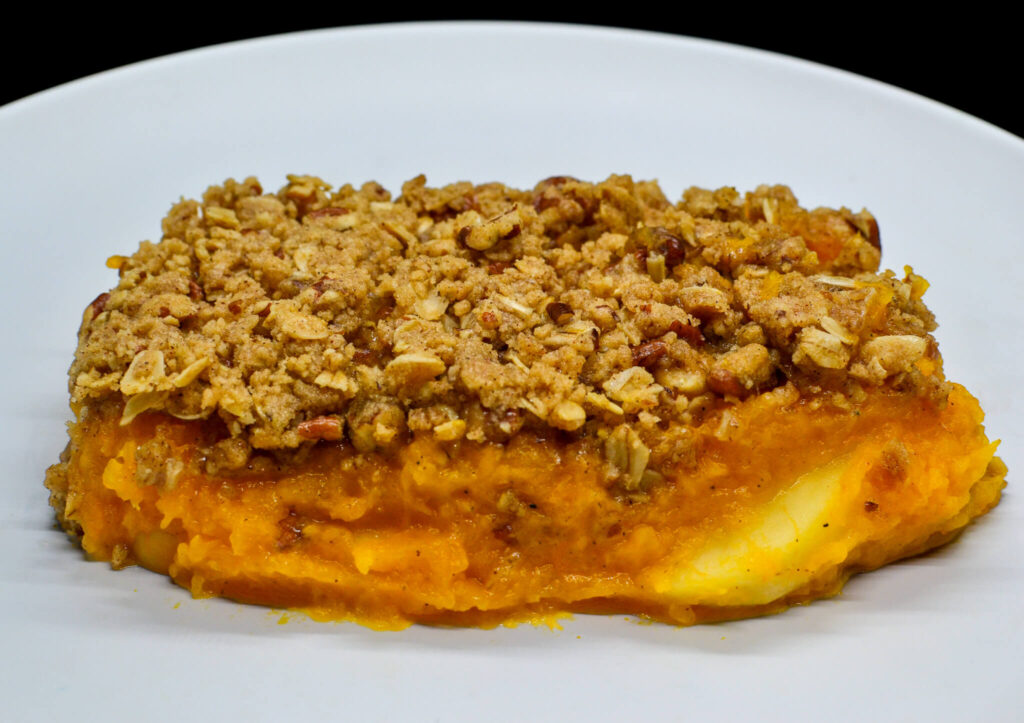
What Is Butternut Squash and Apple Casserole?
Butternut Squash and Apple Casserole, a delightful side dish, expertly combines the sweet flavors of butternut squash and apples. Infused with a mix of fall spices and topped with a crunchy, nutty layer, this casserole is a favorite during the cooler months and holiday gatherings like Thanksgiving. It brings both a rich taste and a festive flair to the table.
Ingredients For Butternut Squash and Apple Casserole
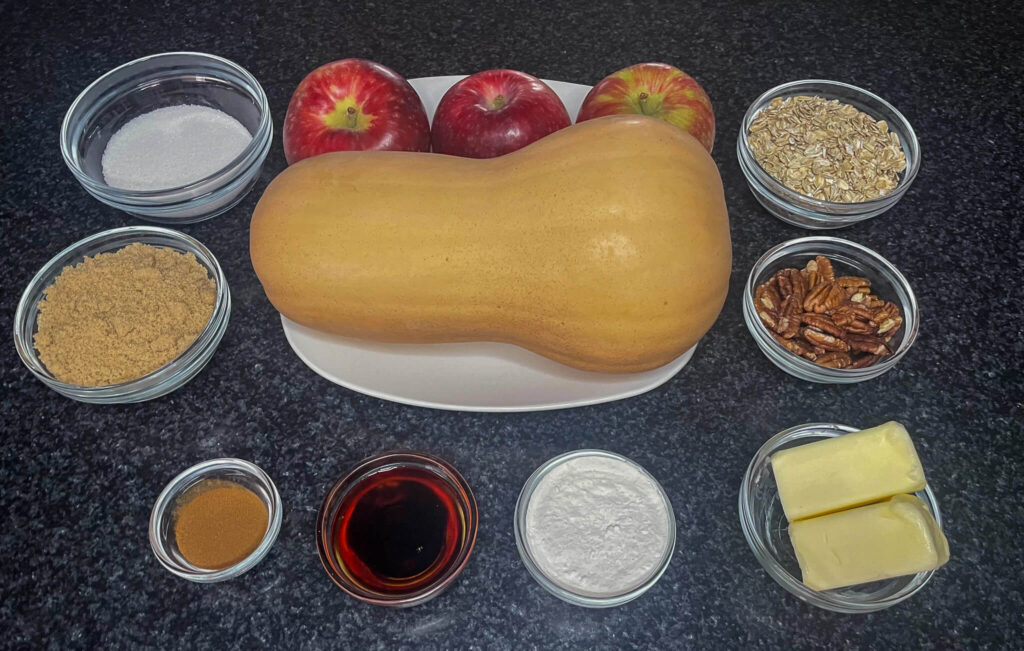

Produce
1 Large Butternut Squash
3 Medium-sized Apples
Refrigerated
1 Stick of Butter

Grocery
1/4 Cup Granulated Sugar
1/2 Cup Brown Sugar
1 Cup Oats
1/2 cup Pecans
1/4 Cup Maple Syrup

Spices
1 Tsp Cinnamon
How To Make Butternut Squash and Apple Casserole
Step 1
Prep & Cook Butternut Squash
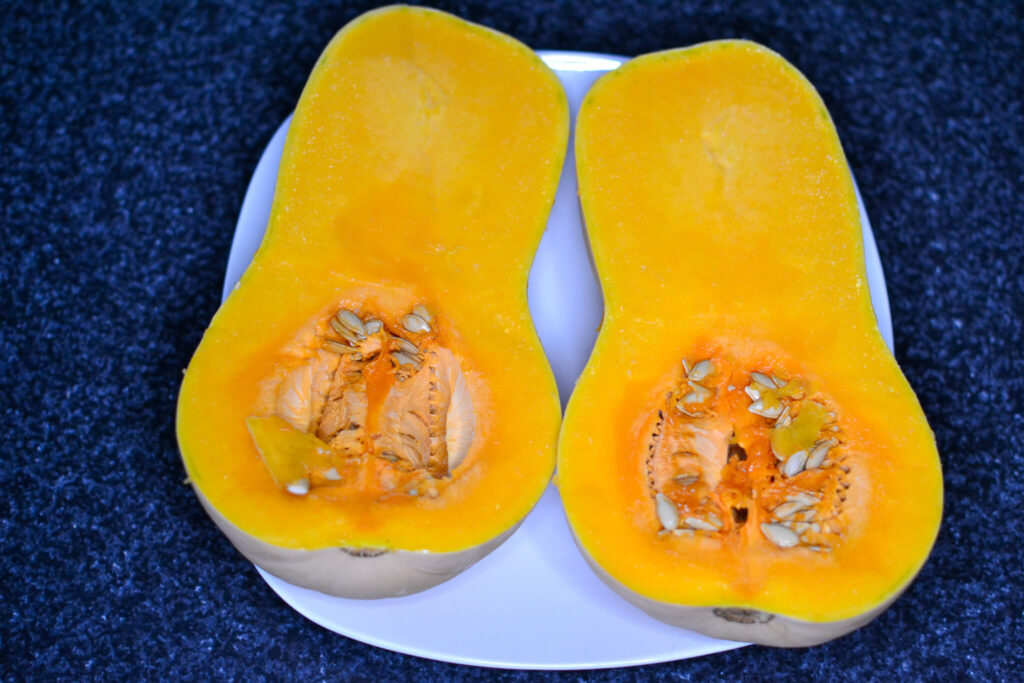
The first and most important step in our butternut squash casserole recipe is to prepare the produce.
Prepping the Butternut Squash
- Start with a Firm Squash: Choose a butternut squash that feels heavy for its size and has a solid beige color. No bruises or soft spots should be present.
- Cutting the Squash: Place your squash on a sturdy cutting board. Using a sharp chef’s knife, carefully slice the squash in half lengthwise. This will require a bit of force, so be careful and keep your fingers away from the blade.
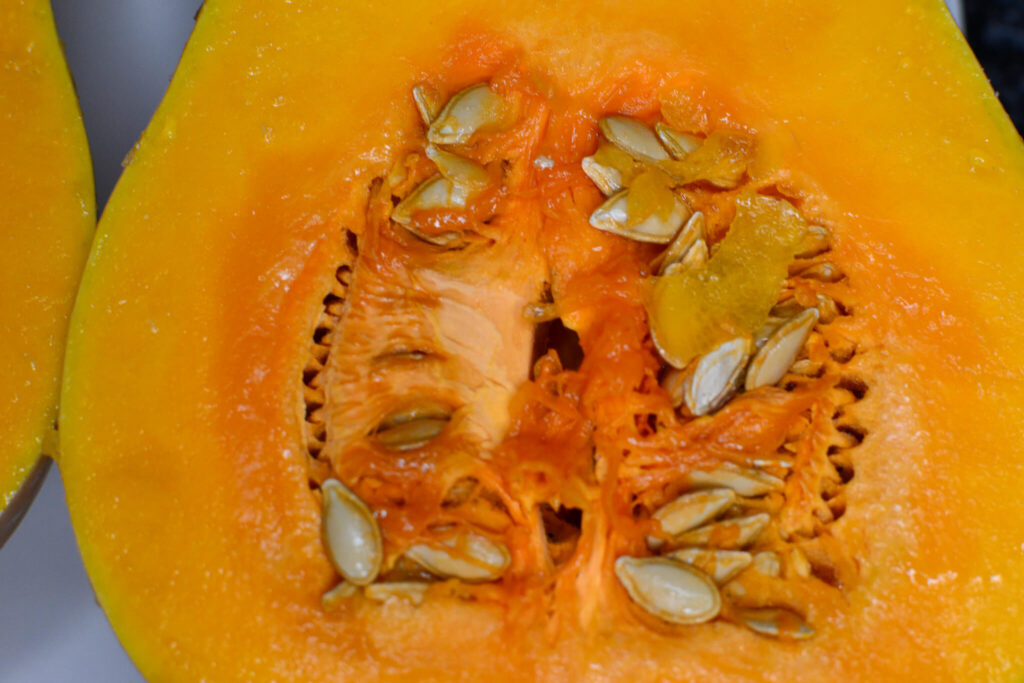
- Scoop Out the Seeds: Once split, you’ll see a hollow section in each half filled with seeds and stringy pulp. Use a spoon to scoop out the seeds and pulp. This part can be a bit messy, but it’s important for the texture of your casserole. You’ll notice the seeds are similar to pumpkin seeds and are surrounded by a fibrous, stringy flesh.
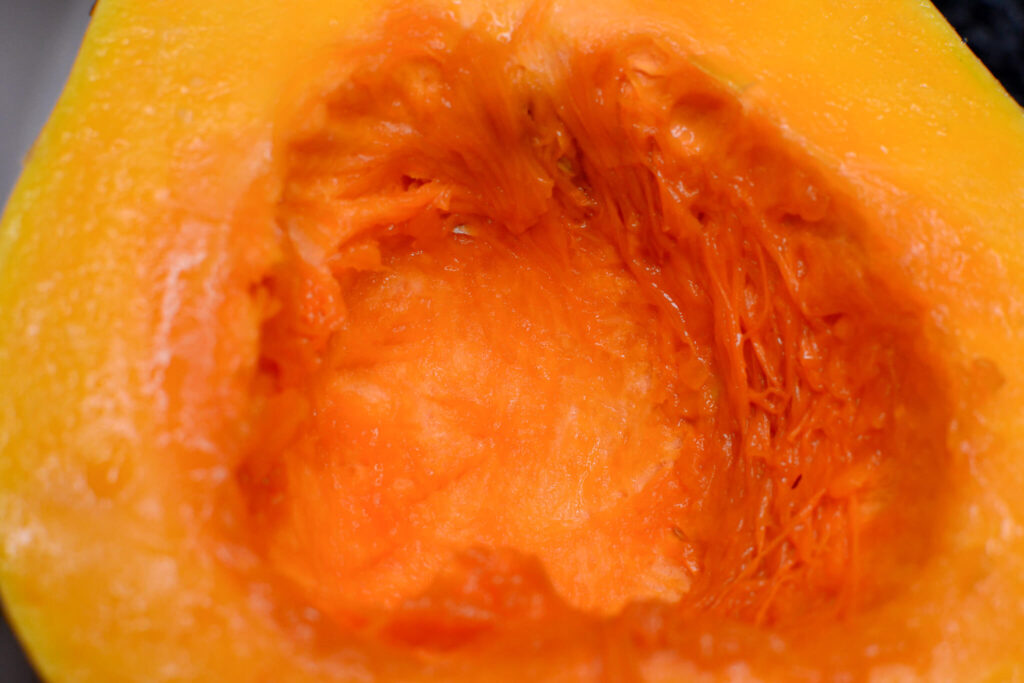
- Post Seed-Removal: After removing the seeds, your squash halves should have smooth, clean cavities.
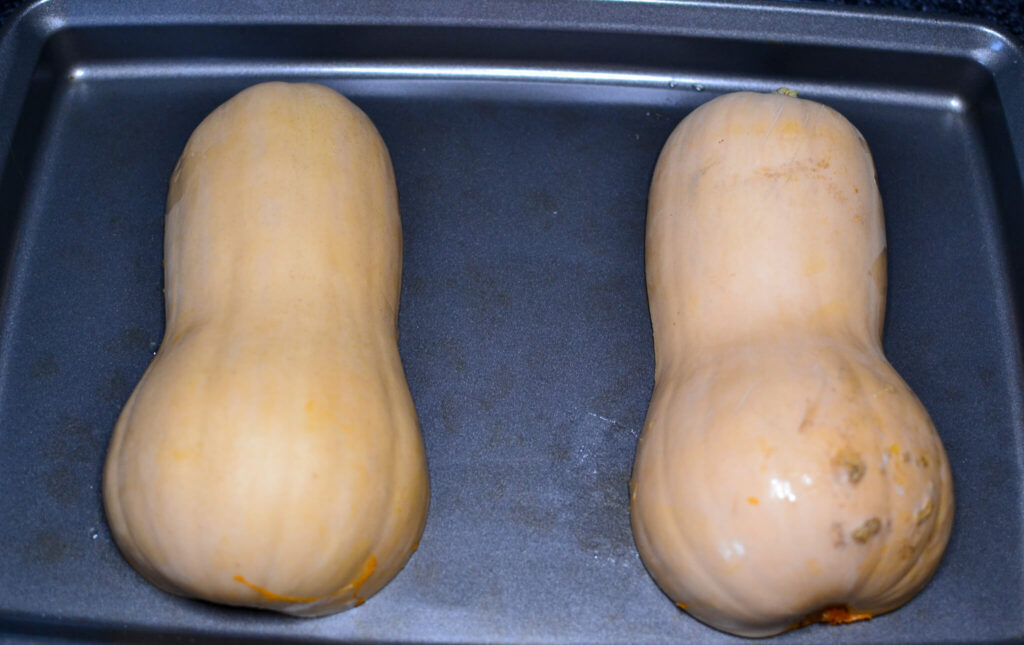
- Preheat Your Oven: Set your oven to 375°F (190°C).
- Prepare for Roasting: Position the squash halves, cut side down, on a parchment paper-lined baking sheet and drizzle some olive oil over them. This arrangement allows for even cooking and helps the squash develop a delicious, caramelized edge. Alternatively, using cubed butternut squash can allow for even cooking and help the squash develop a delicious, caramelized edge.
- Bake the Squash: Roast in the preheated oven for about 45 minutes to an hour, or until the flesh is tender and easily pierced with a fork. Allow it to cool for 25 minutes, as the butternut squash becomes difficult to scoop when it’s too hot.
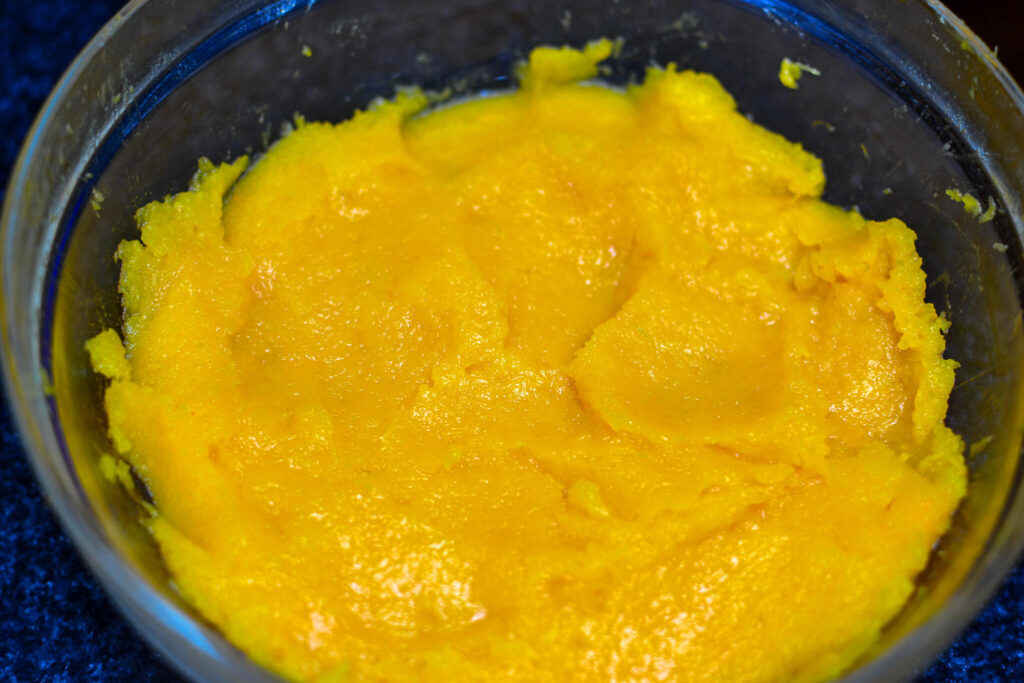
- Cooked Butternut Squash: Once your butternut squash is perfectly roasted and tender, transfer the warm cubes into a large bowl. This is where you’ll mix in the flavors to transform the squash into a casserole delight.
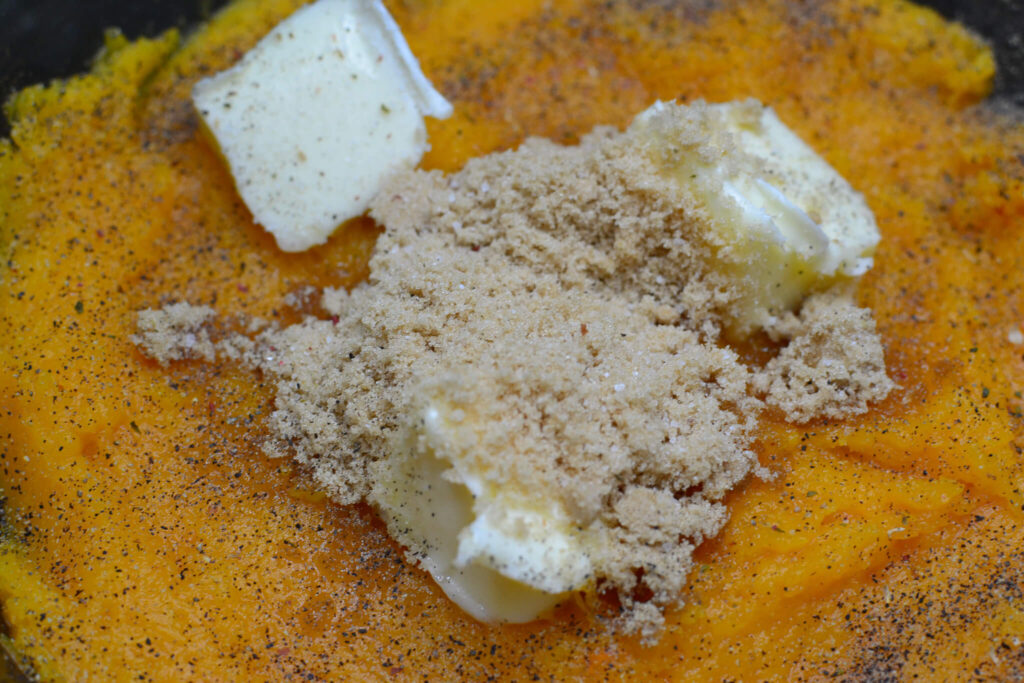
- Adding Butter: Start by adding a generous dollop of butter to the warm squash. The heat from the squash will melt the butter, allowing it to coat each piece evenly. Butter adds a rich, creamy texture and a hint of savory flavor that pairs beautifully with the squash’s natural sweetness.
- Incorporating Brown Sugar: Sprinkle brown sugar over the squash. The amount can be adjusted according to your taste. Brown sugar will not only sweeten the dish but also give it a lovely caramelized flavor, enhancing the inherent nuttiness of the squash.
- Seasoning the Mix: Now, it’s time for the seasonings. Add a pinch of salt, a dash of cinnamon, and a sprinkle of nutmeg. These spices are key to creating a warm, aromatic profile that complements both the squash and the apples.
- Mixing It All Together: Gently mix the butter, brown sugar, and spices with the squash. Ensure each piece is well-coated with this delightful mixture. The goal is to evenly distribute the flavors, creating a harmonious blend that will make your casserole stand out.
- Setting Aside for Assembly: Once everything is mixed well, set your seasoned squash aside, which allows the flavors to meld together.
Step 2
Prep & Cook Apples
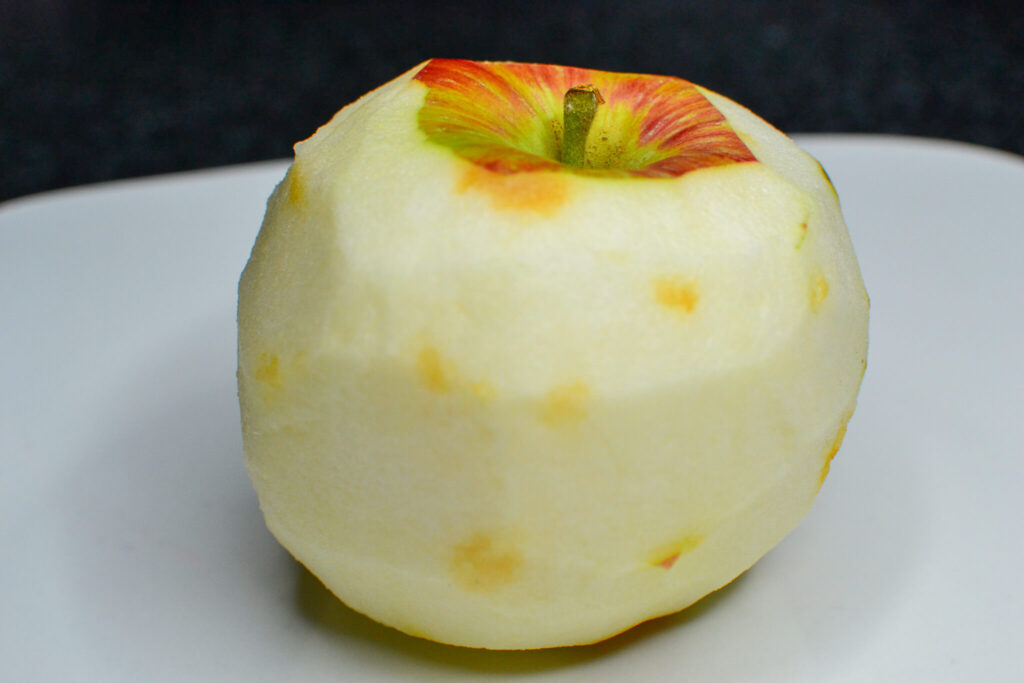
- Select the Right Apples: Choose firm, crisp apples like Honeycrisp or Granny Smith for the best flavor and texture in your casserole.
- Skinning the Apple: Peel the apples to remove the skin, which can be tough after baking. A vegetable peeler or a sharp knife works well for this.
- Slicing the Apples: Once peeled, use an apple cutter to core and slice the apples into even wedges. This ensures they cook uniformly and integrate nicely with the squash.
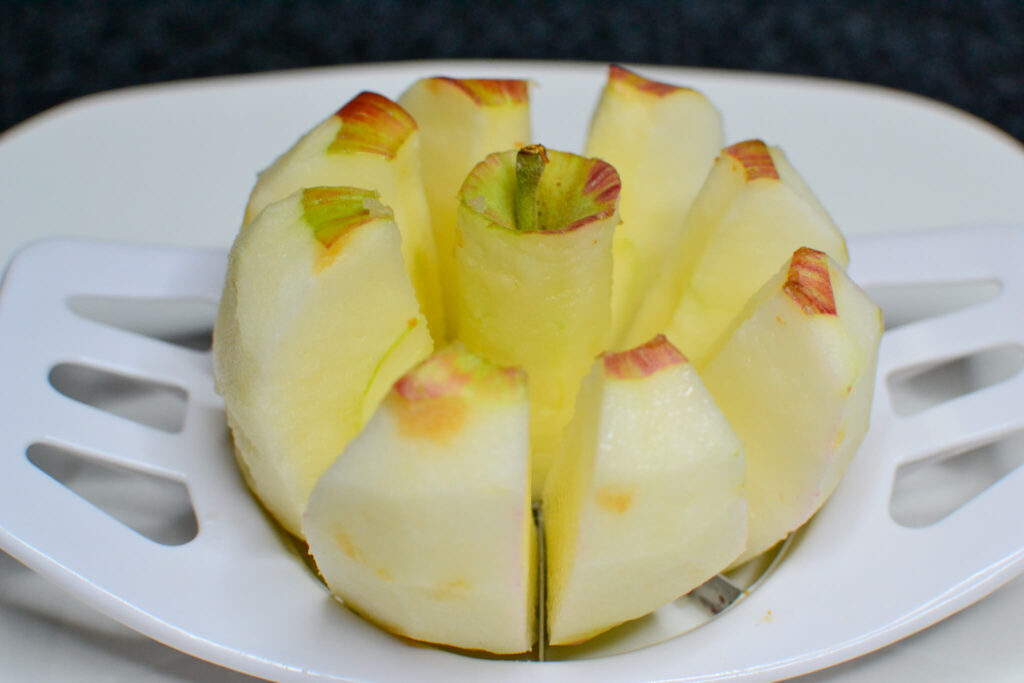
- Melting Butter in the Frying Pan: Start by adding a generous amount of butter to your frying pan. Heat the pan over medium heat until the butter has fully melted and starts to sizzle slightly. This buttery base will not only add flavor but also help in evenly cooking the apples.
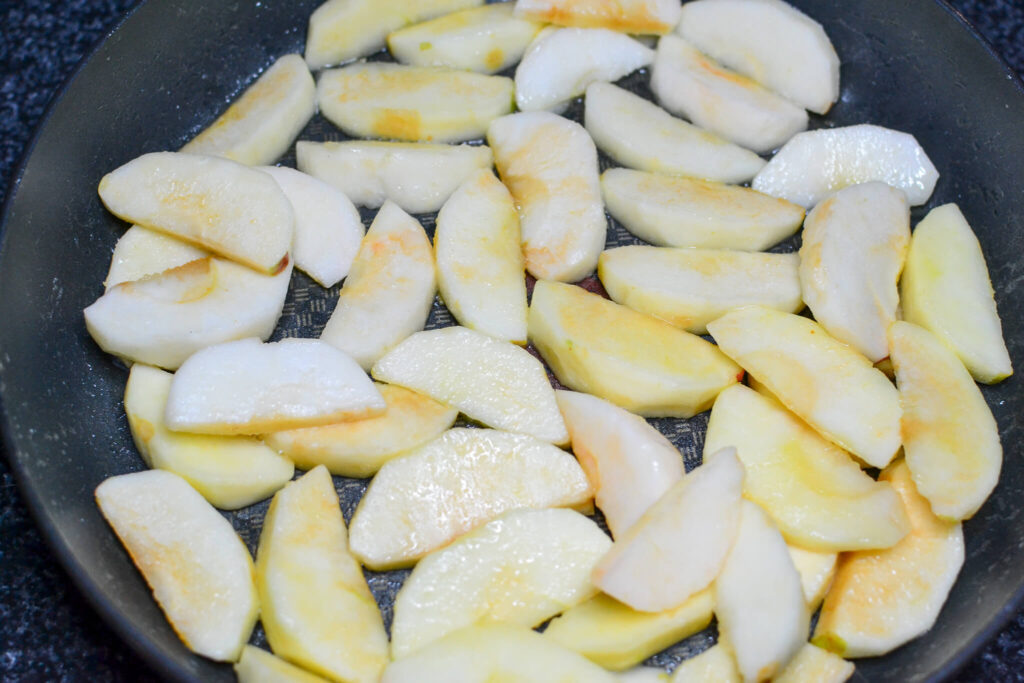
- Apples in the Frying Pan: Begin by placing your prepared apple slices in a large frying pan. Spread them out evenly. This step is crucial for ensuring that each apple slice gets cooked through and absorbs the flavors we’ll be adding.
- Adding Granulated Sugar: Sprinkle granulated sugar over the apples in the pan. The sugar will not only sweeten the apples but also help them caramelize, giving them a beautiful golden color and a rich, deep flavor.
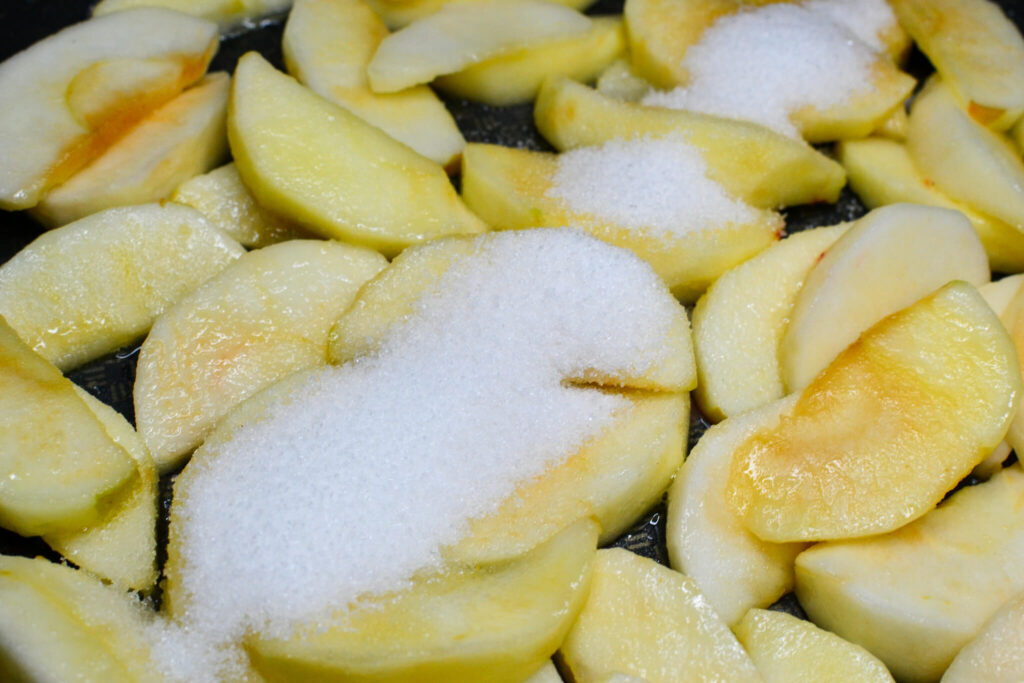
- Cooking the Apples: Set the heat to medium and begin cooking the apples, stirring them gently but often. Watch as the apples turn a light brown and the sugar dissolves, forming a delicious syrup that coats each slice.
- Monitoring the Texture: Keep an eye on the apples as they cook. You want them to become tender but not mushy. The goal is to soften the apples while maintaining some of their natural crispness, which will add a lovely texture to your casserole.
- Checking for Doneness: The apples are done when they are soft to the bite but still hold their shape. You’ll notice the syrup in the pan thickening and the apples taking on a slightly translucent appearance.
- Setting Aside for Assembly: Once your apples are perfectly cooked, remove the pan from the heat. Let the apples cool slightly; this will make them easier to handle when assembling the casserole.
Step 3
Make Topping
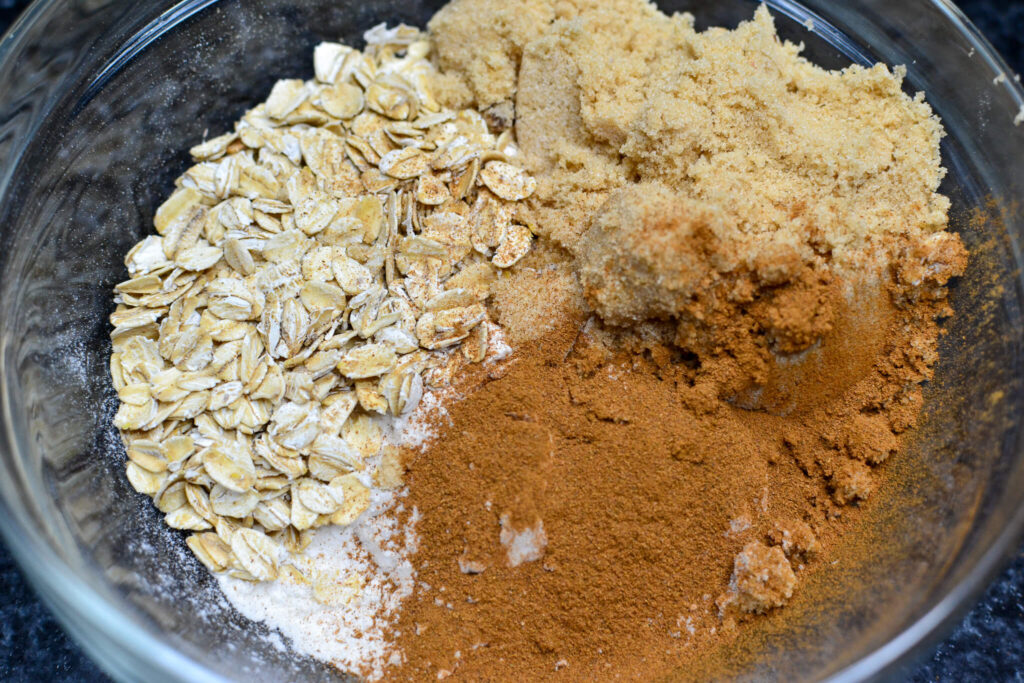
Creating the perfect topping is essential for this type of casserole, as it adds texture and an extra layer of flavor. Your pictures guide us through an ideal process for making a crunchy, sweet, and nutty topping.
- Combining Oats, Sugar, and Spices: Begin by mixing oats with a blend of sugar, brown sugar, and cinnamon in a bowl. This combination will form the base of your topping. The oats provide a hearty texture, the sugars add sweetness, and the cinnamon contributes a warm spice flavor.
- Adding Butter: Next, incorporate cubes of cold butter into the oat mixture. Use your fingers or a pastry cutter to mix the butter in until the mixture resembles coarse crumbs. The butter will help bind the ingredients together and create a rich, crumbly texture when baked.
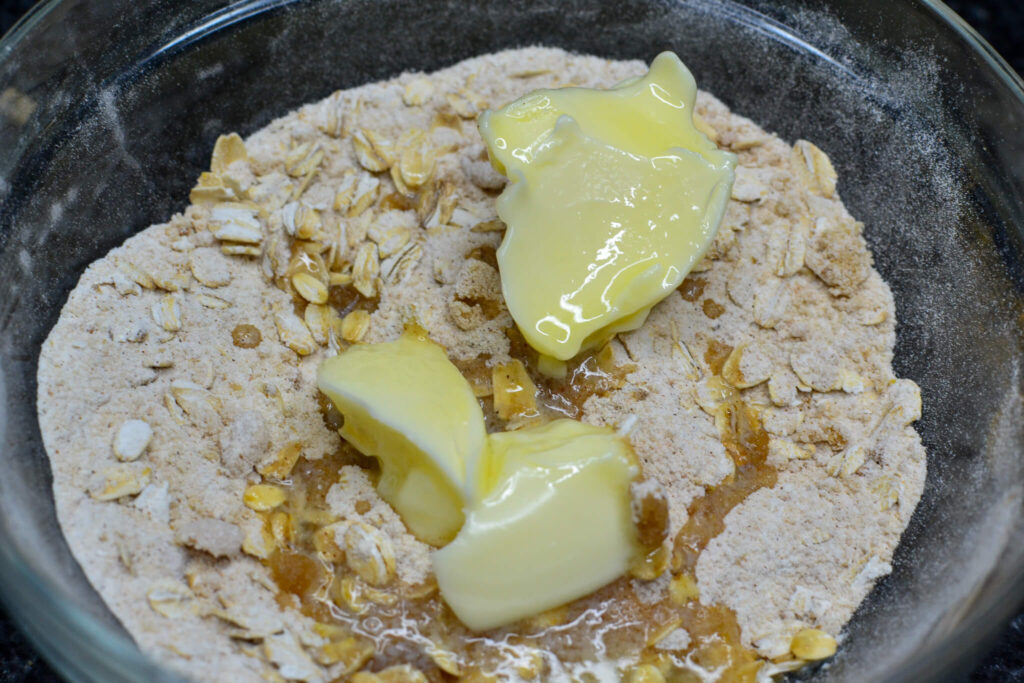
- Incorporating Pecans and Maple Syrup: To enhance the crunch and taste, mix in chopped pecans and a bit of maple syrup. Alternatively, chopped walnuts can be used as a substitute for pecans. The pecans or walnuts add a pleasant nutty flavor, while the maple syrup provides a natural sweetness that pairs well with the other ingredients.
 2
2
- Mixing Thoroughly: Ensure that all the ingredients are evenly mixed. The topping should have a moist, crumbly consistency – not too dry, but not overly wet. This is crucial for achieving the perfect texture when baked.
- Setting Aside for Assembly: Once your topping is well-mixed, set it aside. It will be the final layer of your casserole, adding a deliciously crunchy contrast to the soft and flavorful layers beneath.
Step 4
Assemble
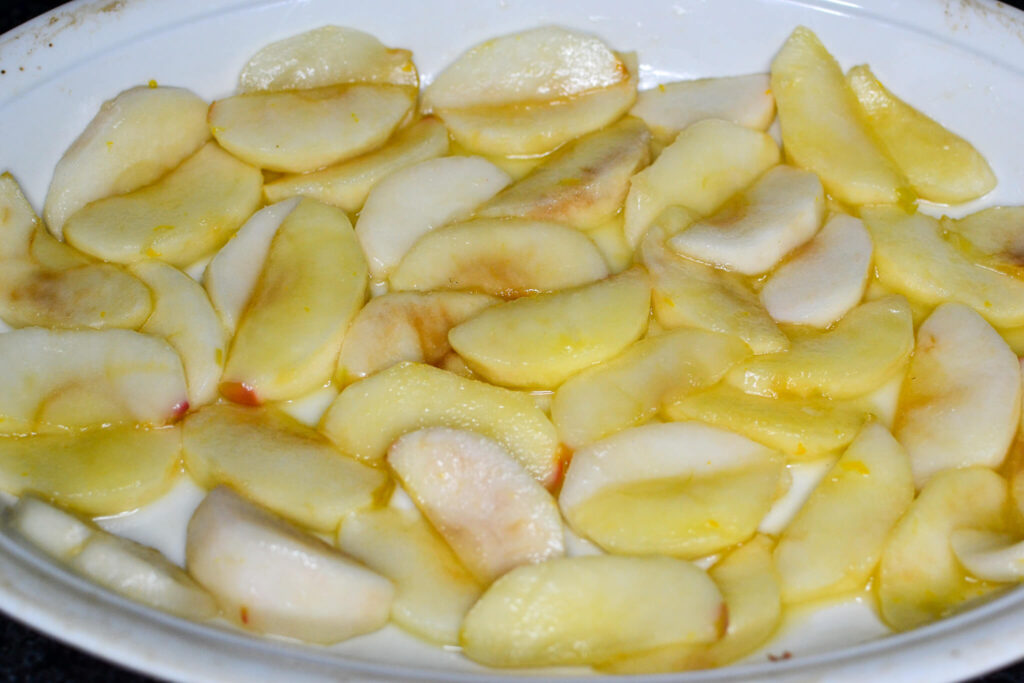
Assembling your casserole is the final step in bringing together all the beautifully prepared components. Your pictures guide us through this crucial stage, ensuring each layer contributes to a harmonious and flavorful dish.
- Layering the Apples: Begin by placing your cooked apples at the bottom of a well-greased baking dish. Spread them out evenly to form a deliciously sweet and tender foundation for your casserole.
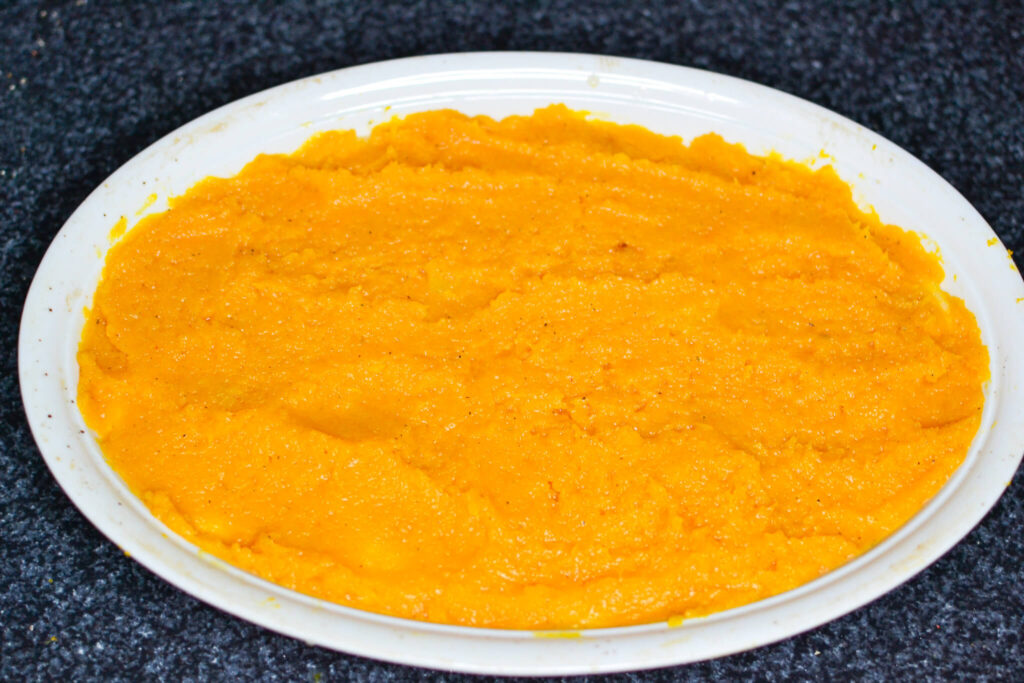
- Adding the Butternut Squash: Next, take your seasoned butternut squash and layer it over the apples. Spread the squash evenly, covering the apples completely. This layering not only creates a beautiful visual contrast but also allows the flavors of the squash and apples to meld together during baking.

- Applying the Topping: Finally, sprinkle your oat, sugar, butter, pecan, and maple syrup topping evenly over the butternut squash layer. Ensure the topping covers the entire surface, as this will add a delightful crunch and sweetness to every bite of the casserole.
- Preheating the Oven: While assembling the casserole, preheat your oven to 350°F (175°C). This ensures the oven is ready and at the right temperature to bake your casserole to perfection.
- Ready for Baking: With the casserole fully assembled, it’s now ready to be baked. The baking process will meld the flavors of each layer together, creating a cohesive, comforting, and delicious dish.
Step 5
Enjoy Your Butternut Squash and Apple Casserole!

Your casserole, full of fall flavors, is ready to enjoy. This easy dish brings together the sweetness of apples and the hearty taste of butternut squash, all topped with a crunchy crust. It’s a perfect mix of simple ingredients that taste great together.

Living With Yourself

Inspiration
Episode 3, Miles clone cooks for Kate

More About Butternut Squash and Apple Casserole
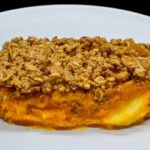
Butternut Squash and Apple Casserole
Ingredients
- 1 large Butternut Squash
- 3 Apples
- 4 Garlic Cloves
- 1 stick Butter
- 1/4 cup Granulated Sugar
- 1/2 cup Brown Sugar
- 1 cup Rolled Oats
- 1/2 cup Pecans
- 1/4 cup Maple Syrup
- 1 tsp Cinnamon
- 1/2 tsp Nutmeg
- 1/4 tsp Salt
Instructions
Prep & Cook Butternut Squash
- Select a firm butternut squash with a solid beige color, free from bruises or soft spots. Place it on a sturdy cutting board and carefully slice it in half lengthwise using a sharp chef’s knife.
- Scoop out the seeds and stringy pulp from each half using a spoon, leaving smooth, clean cavities.
- Set your oven to 375°F (190°C).
- Arrange the squash halves, cut side down, on a parchment paper-lined baking sheet. Drizzle with olive oil to help with caramelization.
- Bake in the preheated oven for about 45 minutes to 1 hour, or until the flesh is tender and easily pierced with a fork. Allow the roasted squash to cool for 25 minutes.
- Once cooled, scoop the roasted squash into a large mixing bowl.
- Add the melted butter, 1/4 cup granulated sugar, and 1/2 cup brown sugar to the squash. Stir until the butter and sugars are well incorporated.
- Sprinkle in 1/4 tsp salt, 1 tsp cinnamon, and 1/2 tsp nutmeg. Gently mix to ensure even distribution of spices.
- Let the seasoned squash mixture sit to allow flavors to meld.
Prep & Cook Apples
- Choose firm, crisp apples like Honeycrisp or Granny Smith. Peel them, then slice into even wedges.
- In a large frying pan, melt a generous amount of butter over medium heat. Add the sliced apples, spreading them out evenly.
- Sprinkle 1/4 cup granulated sugar over the apples to help caramelize them.
- Sauté the apples, stirring gently but often, until they turn light brown and the sugar dissolves, about 5-7 minutes. The apples should be tender but still hold their shape.
- Remove the apples from the heat and let them cool slightly.
Make Topping
- In a medium bowl, mix 1 cup rolled oats, 1/4 cup granulated sugar, 1/2 cup brown sugar, and 1 tsp cinnamon.
- Incorporate 1/2 cup melted butter into the oat mixture using your fingers or a pastry cutter until the mixture resembles coarse crumbs.
- Stir in 1/2 cup chopped pecans and 1/4 cup maple syrup until everything is evenly coated and crumbly.
- Reserve the topping mixture for layering on the casserole.
Assemble
- Lightly grease a large baking dish to prevent sticking.
- Spread the caramelized apples evenly at the bottom of the dish.
- Top with the seasoned butternut squash mixture, ensuring it covers the apples completely.
- Evenly sprinkle the oat, sugar, pecan, and maple syrup topping over the squash layer.
Bake
- Place the assembled casserole in the preheated oven and bake for 30 minutes, or until the topping is golden brown and crunchy.
- Remove from the oven and let the casserole cool for a few minutes before serving.
Serve
- For an extra touch, you can garnish with a sprinkle of additional chopped pecans or a drizzle of maple syrup.
- Serve warm as a delightful side dish during your favorite fall meals or holiday gatherings.

